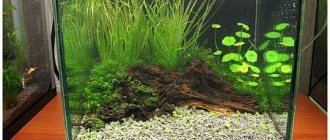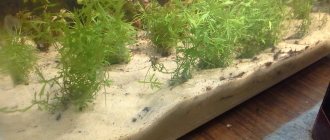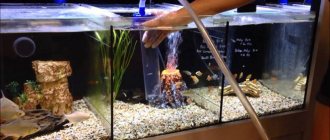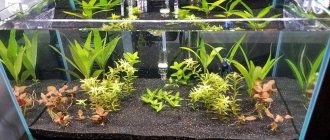Many aquarium owners, when choosing soil, pay more attention to its decorative properties than to its functionality. In fact, this important component plays a major role in the well-being of all inhabitants. The soil for individual species of fish and plants is selected taking into account their characteristics in order to create the most comfortable conditions.
Using untreated river sand or fine gravel, there is a risk of death of aquatic life, as well as active algal bloom. Knowing some rules and features of soil selection, you can create a unique decorated aquarium in which all inhabitants of the environment will be comfortable.
Why do you need soil?
The bottom flooring is one of the most important elements of the aquarium. Its key role is to filter harmful substances that form in the water during the period of active life of the fish. The soil contains colonies of beneficial bacteria that neutralize pathogenic bacteria and create optimal living conditions for fish, shrimp, snails and plants.
Secondary tasks of aquarium flooring:
- Substrate for the development of the root system of plants - by adjusting the thickness of the layer, you can control the growth of aquatic plants, as well as choose different options with a developed root system.
- Habitat for bottom fish - some species burrow into the ground, which provides comfort and protection.
- Changing the acid-base balance in the desired direction - this property is used for decorative aquariums that house fish that are sensitive to changes in pH, which is extremely difficult to control at home.
With the help of soil, you can decorate even the most boring aquarium by laying out interesting drawings and implementing original solutions. If we take into account the benefit-beauty ratio, then the first parameter should always prevail, since incorrectly selected soil means:
- inhibition of fish growth, poor appetite, intoxication with waste products, death;
- wilting of plants, lack of development of the root system;
- rapid clouding of water and the need for frequent filter cleaning;
- unpleasant smell from the aquarium.
Our task is to combine several requirements at the same time: so that the fish are comfortable, the plants actively develop, and the aquarium becomes a real pearl of the room.
Aquarium preparation
Now a little about the aquarium itself. For experiments with the ground, a container with a volume of about 60 liters was allocated. It is located in the center of the bedside table, under the main 360 liter aquarium. Due to the peculiarities of the location, some problems arose with lighting; the fact is that standard aquarium lamps were not suitable in size and power.
Cabinet and place for a future aquarium
I decided to assemble the lighting myself using regular E-14 sockets and energy-saving lamps. I used regular clamps for plumbing pipes as holders for the cartridges. I attached all this to a metal corner, and it, in turn, secured it to the wall of the bedside table. A few photos for clarity.
Cartridges for lighting an aquarium with ground Cartridges for lighting an aquarium with ground general view
In the future I will make reflectors or cover the lamps with a panel. Only a 100W heater will be used as equipment for a ground aquarium. By the way, the company produces good aquarium equipment; at least I haven’t had a single failure in 3 years. The heating pads, pump and Atman DF-1000 filter work properly. I also installed an internal Aquael Fan micro filter with a capacity of about 250 liters/hour. As a filter, it certainly doesn’t work. I just don’t understand what colonies of bacteria that provide filtration should settle on a sponge the size of a matchbox. Yes, we don’t need this, so the fan took out the sponge and the task of the fan was simply to slowly mix the water in the aquarium. There are no plans to use any more equipment.
Internal filter Aquael Fan micro
The back wall was covered with regular black self-adhesive film.
Background self-adhesive film
The last fitting for the location of the aquarium in the bedside table.
Aquarium in its place
Principles and rules of selection
Before you go shopping, take a pen (or better yet, colored pencils) and a piece of paper. Draw your aquarium and figure out exactly what the bottom should look like. After this, write down the key points that will be needed in the future when choosing a bottom flooring:
- What kind of fish is the aquarium intended for? Each species has its own requirements for the composition of water, and the soil can change it, increasing acidity or alkalizing it.
- What plants will grow in the aquarium? Species with a developed root system need heavy and porous soil, but surface ones do not have such requirements.
- What color scheme will the aquarium have and how will it match its inhabitants?
- Does the aquarium have a filter or not? Strong filtration pumps are capable of drawing in fine sand, which leads to their rapid deterioration.
- What is the volume of the aquarium? Necessary to determine the amount of soil.
After all the necessary parameters have been outlined, you should understand the types of soils and their possibility of use in a particular case.
Fraction size
It completely depends on what kind of fish and plants will be in the aquarium.
According to the famous aquarist S.V. Obraztsov, the larger the fish, the thicker the bottom layer should be and the larger the soil fraction. The same rule applies to aquatic plants. Fine-grained fillers will not be able to support the massive root system of plants, which will lead to inhibition in their growth and development.
Some large fish are capable of swallowing small particles of soil, which, at best, will negatively affect the functioning of the digestive system, and at worst, death.
Type of fish
Conventionally, all fish when choosing soil can be divided into 2 categories:
- Demanding (loach, cockroach, acanthophthalmus, macrognathus, corydoras, ancistrus, agamixis): the soil should be selected so that the fish can freely burrow into it, and the water does not become additionally alkalized.
- Neutral (danio, barb, cardinal, guppy, gourami, neon): soil is chosen taking into account the size of the fish, as well as behavioral characteristics.
If there are bottom inhabitants in the aquarium, then areas with fine-grained soil must be allocated for them, in which they can burrow. If this condition is not provided, the fish will experience constant stress and will not be able to fully develop.
Plant types
Representatives of the aquarium flora are divided into 3 groups:
- With a developed root system - they need several layers of soil, as well as feeding and fertilizing under the bush.
- With a minimal root system, it grows and develops well in any type of aquatic soil.
- Without rooting - they live in the water column or on its surface.
If you are not sure that exotic plants will take root and become a full-fledged part of the aquarium, then you can choose the simplest specimens, for the cultivation of which the most common and inexpensive types of soil are suitable.
Some fish, during mating season or stressful situations, can tear out plants planted in the ground. For this purpose, experts recommend further strengthening them with the help of large stones, shells, pots and decorative items.
Filler type
Since the main task of soil is to purify water and destroy pathogenic flora, its type is extremely important when choosing. There are:
- Natural – all fractions of gravel, sand, pebbles. It is the most common and optimal option for all types of fish, since during use it does not emit toxic substances and does not saturate the water with microelements that could change its composition.
- Processed natural – ground glass, expanded clay, painted dolomite, coral sand. It serves a rather decorative role, but can be used in small quantities for certain types of fish.
- Artificial - made from non-natural components that do not affect the composition of water in any way. You can choose any color scheme and decorate the aquarium according to your own wishes.
| Soil type | Advantages | Flaws |
| Natural | affordable price, easy to care for, does not change the acid-base composition of water, heavy weight, holds large plants well without additional strengthening | minimum nutrients for plants |
| Processed natural | various decorative elements, easy to use and clean, does not affect the water and the inhabitants of the aquarium | poor flora for plants, some coarse elements are lighter than water and can be moved by currents or large fish |
| Artificial | good microcirculation; lasts longer than natural, easy to clean | not used for planting |
Experts recommend combining several types of soil so that plants grow well, bottom fish have somewhere to burrow, and other inhabitants feel comfortable and safe.
Color scheme and decor
In this case, only the aquarium owner decides what kind of soil will be appropriate. Some advice from an expert:
- The white filler more clearly reflects the presence of waste products of the inhabitants. If feces are practically invisible on a gray-green surface and are disposed of naturally, the bright colors of the soil give away secrets.
- The dark shade shows the fish in their best light. All attention is focused on the inhabitants, and not on decorative elements.
- For dark soil, any type of illumination can be used, while with bright illumination of a light substrate there is a risk of distorting the shape of the bottom.
Any decorative elements that are part of the ground must be made only from suitable materials. You should not form the bottom from objects that are not intended for prolonged contact with water. This will not only affect the composition of the water, but will also have a detrimental effect on the life of the fish.
How to Determine Which Substrate to Use
In order for the fish to feel good, it is necessary to use the best cover for the aquarium. Poor quality material not only does not perform its functions, but can also harm the inhabitants. When choosing a soil mixture, the following criteria should be taken into account.
Thickness and size
A correctly selected fraction allows the necessary amount of oxygen to pass through for algae growth. For plants, the medium type fraction is used. Also, the size of the particles may depend on the habits and size of the fish. For small fish, preference should be given to small varieties of the mixture. Coarse soil is used for large-sized inhabitants.
Form
The particles can be round in shape. This type of particles is often used for small fish to prevent injury during contact with the coating. Sharp particles can be used for large fish.
Availability of nutrients
Nutrient soil is necessary for containers where vegetation is grown in large quantities. If artificial mixtures are used, this problem is solved with the help of special tablets that contain the necessary nutrients.
Color tone
Colored soil is used to decorate an aquarium. The flooring can be of different colors, which allows you to get creative with the design of the container.
Effect on water
Some types of bottom covering mixture can affect water quality. For example, white aquarium soil contains a component such as limestone. The breed makes the water hard, which negatively affects the development of some fish species.
What is strictly forbidden to use as a primer?
In order to save money, some aquarium owners form the soil from those components that are not suitable for these purposes, endangering all living things. Never use:
- Expanded clay cat litter - when in contact with water, it can cause cloudiness and a change in acidity towards alkalization. They contain flavorings and a lot of inclusions that are dangerous for fish.
- Marble and shell rock - upon prolonged contact with water, release calcium carbonate, which makes the water hard and unsuitable for some species of fish.
- Fine glass filler – there is no porosity necessary for the development of beneficial microflora. Suitable as a bulk decorative element of a separate part of the aquarium, but not for full-fledged soil.
- Garden soil and substrates for indoor plants containing peat and mineral inclusions - upon contact with water, an oxidation process occurs, which causes rotting. Such microflora is destructive for most fish.
To check a commercial aquarium filler for the presence of high calcium carbonate content, you need to drop a few drops of vinegar onto its dry surface and observe the result. If small bubbles appear, it means the soil will change the composition of the water to the alkaline side.
Acid helps neutralize high concentrations of alkali. To do this, the soil is laid out in a flat container in the thinnest layer possible and filled with vinegar. Let stand for several hours, then rinse well with cold water.
I added bright gravel to my tank and my pH increased, why?
Many bright colored soils are made from white dolomite. This natural mineral is rich in calcium and magnesium, and the colorless varieties are sold for use in saltwater aquariums and African cichlid aquariums to improve water hardness.
If you have hard water in your aquarium, or you keep fish that do not pay much attention to water parameters, then you have nothing to worry about. But for fish that need soft water, such soil will be a real disaster.
Universal primer
The easiest way to care for basalt and gravel filler with a fraction of 3-5 mm.
Such sizes fully satisfy the needs of plants for root aeration, allow beneficial flora to form on the surface, and also do not interfere with bottom inhabitants burrowing. This soil is easy to care for: it is enough to wash it under running water once every 2-3 months, and treat it with special antibacterial agents for aquariums once every six months.
The water does not bloom, does not change its characteristics, does not become cloudy and the root system of plants does not rot.
Rules for laying the substrate
The soil for an aquarium can be of different types, which is best chosen by the user, depending on the types of inhabitants and the amount of vegetation. However, the selected substrate must be laid correctly. It is recommended to follow the following rules:
- Before placing it in the aquarium, the substrate must be thoroughly rinsed with running water;
- A nutrient layer is placed on the bottom if plants are to be grown. The layer thickness should be no more than 1 cm;
- the substrate is carefully scattered along the bottom. The thickness of the soil in the aquarium should not exceed 7 cm;
- the height of the flooring near the back wall should be several cm higher than the thickness near the front;
- level the surface using a wooden spatula;
- If natural stones are used as decoration, they must first be cleaned.
Before laying the first layer, it is necessary to carefully calculate the mass of the required substrate. On average, 1 kg of finished material is used for a volume of 5 liters.
Caring for an aquarium begins with the selection of materials for interior design. When growing vegetation, it is recommended to use special mixtures. In order for the flooring to last for a long time, it is necessary to give preference to quality materials and timely maintenance. The health of the fish and the quality of the water depend on the type of material.
The best brands of soil for an aquarium
It’s good if the money spent on equipping the aquarium fully pays for itself. It is much sadder to watch how plants wither, their roots rot, and fish fall into suspended animation.
Some unscrupulous manufacturers conceal information that their soil compositions can affect the composition of water. Therefore, the following manufacturers are given priority.
UDeco “white gravel”, natural, fraction 3-5 mm
Absolutely safe product, does not affect vegetation and aquatic life. Packaged in convenient packs of 10 kg. Does not cause any difficulties with operation and cleaning. Suitable for fish that need hard water: cichlids, barbs, rainbowfish, molly.
Advantages:
- Porous, does not cause rotting of plant roots
- Does not require pre-treatment with disinfectants
- Slightly increases the concentration of alkali in the form of calcium carbonate
- Does not contain dyes or harmful impurities
Flaws:
- Requires repeated rinsing before use to achieve maximum water clarity
According to reviews, this soil goes well with dark types of gravel, which allows you to create multi-layered bottom landscapes. It has a long service life, maintaining a perfectly even white shade.
"EcoGrunt" marble chips
You can choose different fractions and colors, which will make the aquarium attractive and bright.
Consists of painted marble. Does not affect the transparency and composition of water, but over time it can increase hardness.
It has a low cost. Used for all types of fish.
Advantages:
- The color does not wash out and does not stain water
- Soft, non-traumatic edge of each element
- Suitable for plants with massive roots, does not cause rotting
- Has good porosity
Flaws:
- With prolonged use, it increases the concentration of calcium carbonate
According to reviews, this particular soil is considered universal, since you can choose all its parameters yourself. Does not require pre-treatment or rinsing.
Power Sand Special
Consists of crushed volcanic stone with good porosity. Creates optimal conditions for the development of beneficial flora at the bottom of the aquarium. Non-toxic to flora and fauna. Requires surface covering with conventional gravel or quartz substrate.
Advantages:
- Plants grow well
- High percentage of circulation, which prevents rotting of the root system
- Completely safe for all types of fish
- Suitable for long-term use, easy to clean
Flaws:
- Before planting plants and introducing fish, you need to wait until the water stabilizes.
- The need to cover the top with medium-fraction gravel
Taking into account the reviews, this particular substrate ensures a riot of vegetation in the aquarium, while remaining completely safe for animal representatives.
Kinds
In order to determine what kind of soil is needed for an aquarium, you should carefully study the varieties.
Natural
Natural mixtures contain particles of stones, pebbles, and lava. This type of coating does not contain nutrients. Therefore, additional preparations must be used to grow vegetation. This type of material is often used as decoration. To create natural conditions, large particles of crushed stone are added to the substrate. In order to extend the life of the natural material, it must be rinsed with running water.
Sand is used as a bottom cover. The material may have different fractions. Sand particles of medium size are often used.
Glass material
Very rarely used. Consists of small flat glass particles. It is recommended to use such soil in an aquarium only for decorative purposes. Plants will not be able to grow on glass particles.
Treated substrate
If choosing a soil is difficult, you can use a treated mixture. This substrate contains natural particles of expanded clay, pebbles and gravel. The substrate is suitable for all types of fish, has small particles and does not release harmful elements into the water. Additionally, it is necessary to use fertilizers for plants.
Specialized substrate
If the user does not know which soil to choose for an aquarium, it is necessary to pay attention to this type. Specialized substrate can be divided into subtypes:
- eco-soil - this type of substrate contains marble chips. Used for decorating an aquarium. Not used for plant growth;
- artificial soil - used to decorate an aquarium. The artificial material contains glass and plastic particles. However, such material can be of different colors and will last a long period;
- a mixture of nutrient layer and sand. It is considered the best soil for an aquarium where plants are grown. The nutrient layer saturates the root with essential minerals, the sand allows water to pass through.
When choosing the type of cover for the bottom, you can use several types at the same time. This can be eco-soil mixed with a nutrient mixture. This combination allows you to get the desired design and grow plants.
Requirements
Nutrient soil for the aquarium is selected for each individual. Natural compounds can affect water parameters by releasing soluble substances into the water.
Pebbles typically have a small particle size of up to 8mm, however for larger burrowing fish it is important to select the largest pebble substrate available.
River sand used as a substrate for plants in an aquarium requires proper water circulation to prevent anaerobic processes. The sand should be thoroughly washed and calcined in a frying pan or baking tray. A layer of pebbles should be placed under the sand substrate, since sand particles can be washed out by the flow of water and dissolved.
Relationship between biological balance and soil
Soil is a natural battery that generates biological and mineral substances necessary for the life of all vegetation on Earth, including underwater.
living in the soil process dead organic matter into inorganic compounds .
The resulting substances serve as building materials for plants.
Greenery grown in an aquarium supplies the water with oxygen and is used as food for fish and other living creatures.
When they die, they fall into the soil, decompose and are processed into those same inorganic compounds. The circle of life repeats itself.
This is how the soil works to maintain biological balance in a given ecosystem , that is, in your home aquarium.











